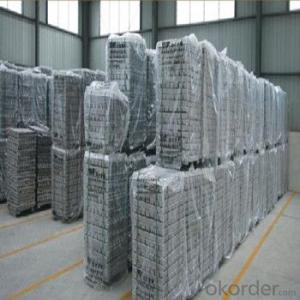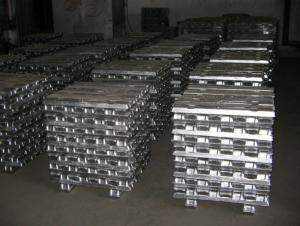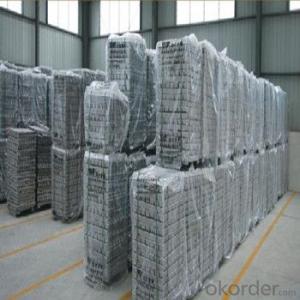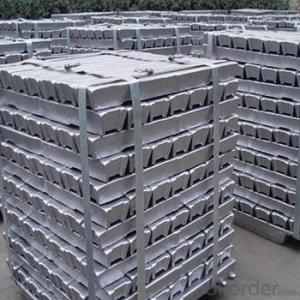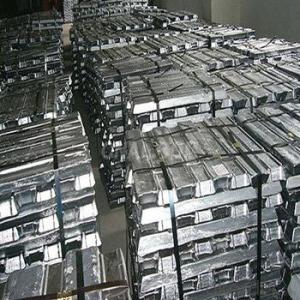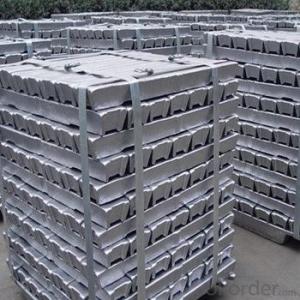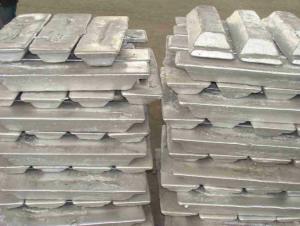Aluminum Ingot From Chinese Supplier Best Quanlity
- Loading Port:
- China main port
- Payment Terms:
- TT OR LC
- Min Order Qty:
- 1000 m.t.
- Supply Capability:
- 10000 m.t./month
OKorder Service Pledge
OKorder Financial Service
You Might Also Like
Pure Aluminum Ingot Used for Industry
1.Structure of Aluminum Ingot Description
An ingot is a piece of material, usually metal, that is cast into a shape suitable for further processing. Insteelmaking, it is the first step among semi-finished casting products.
2.Main Features of the Aluminum Ingot
•Easy control and operation
•Fast melting
•Good price
•Good Service
3. Aluminum Ingot Images
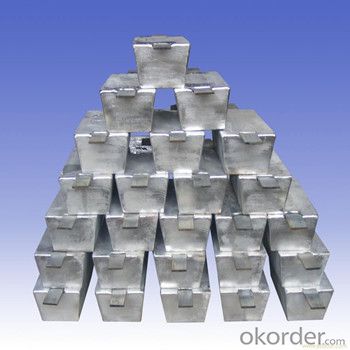
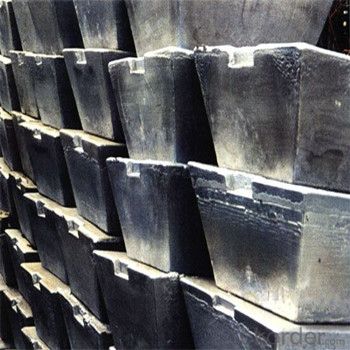
4. Aluminum Ingot Specification
Grade | Chemical Composition % | |||||||||
Al≥ | impurities ≤ | |||||||||
Si | Fe | Cu | Ga | Mg | Zn | Mn | others | Sum | ||
Al99.9 | 99.90 | 0.50 | 0.07 | 0.005 | 0.02 | 0.01 | 0.025 | - | 0.010 | 0.10 |
Al99.85 | 99.85 | 0.80 | 0.12 | 0.005 | 0.03 | 0.02 | 0.030 | - | 0.015 | 0.15 |
Al99.7 | 99.70 | 0.10 | 0.20 | 0.010 | 0.03 | 0.02 | 0.030 | - | 0.030 | 0.30 |
Al99.6 | 99.60 | 0.16 | 0.25 | 0.010 | 0.03 | 0.03 | 0.030 | - | 0.030 | 0.40 |
Al99.5 | 99.50 | 0.22 | 0.30 | 0.020 | 0.03 | 0.05 | 0.050 | - | 0.030 | 0.50 |
Al99.00 | 99.00 | 0.42 | 0.50 | 0.020 | 0.03 | 0.05 | 0.050 | - | 0.050 | 1.00 |
5.FAQ of Aluminum Ingot
We have organized several common questions for our clients,may help you sincerely:
①How about your company?
A world class manufacturer & supplier of castings forging in carbon steel and alloy steel,is one of the large-scale professional investment casting production bases in China,consisting of both casting foundry forging and machining factory. Annually more than 8000 tons Precision casting and forging parts are exported to markets in Europe,America and Japan. OEM casting and forging service available according to customer’s requirements.
②How to guarantee the quality of the products?
We have established the international advanced quality management system,every link from raw material to final product we have strict quality test;We resolutely put an end to unqualified products flowing into the market. At the same time, we will provide necessary follow-up service assurance.
③How long can we receive the product after purchase?
In the purchase of product within three working days, We will arrange the factory delivery as soon as possible. The pecific time of receiving is related to the state and position of customers.Commonly 7 to 10 working days can be served.
- Q:What are the advantages of using aluminum ingots in the production of renewable energy systems?
- There are several advantages of using aluminum ingots in the production of renewable energy systems. Firstly, aluminum is a lightweight material, making it easier to transport and install in various renewable energy systems such as solar panels and wind turbines. This lightweight characteristic also reduces the load on supporting structures, leading to cost savings in terms of materials and installation. Secondly, aluminum has excellent corrosion resistance properties, which is crucial for renewable energy systems that are often exposed to harsh environmental conditions. This resistance ensures the longevity and durability of the systems, reducing maintenance and replacement costs. Additionally, aluminum is highly recyclable, with the ability to be reused repeatedly without any loss in quality. This recyclability aspect makes aluminum a sustainable choice for renewable energy systems, aligning with the goal of minimizing environmental impact. Furthermore, aluminum has high thermal conductivity, allowing for efficient heat dissipation in renewable energy systems. This property is particularly beneficial in applications like solar panels, where excess heat can reduce efficiency. By effectively dissipating heat, aluminum ensures optimal performance and extends the lifespan of the system. Moreover, aluminum ingots can be easily molded and customized into various shapes and sizes, enabling manufacturers to design renewable energy systems with enhanced efficiency. This flexibility in design helps optimize the system's performance and adapt to different project requirements. Lastly, aluminum is a cost-effective material compared to alternatives like steel or copper. The relatively low cost of aluminum ingots allows for more affordable production of renewable energy systems, making them more accessible to a wider range of consumers. In conclusion, the advantages of using aluminum ingots in the production of renewable energy systems lie in their lightweight nature, corrosion resistance, recyclability, thermal conductivity, design flexibility, and cost-effectiveness. These qualities contribute to the overall efficiency, durability, and affordability of renewable energy systems, making aluminum a preferred material in the industry.
- Q:Can aluminum ingots be anodized?
- Aluminum ingots are capable of undergoing anodization. Anodization, an electrochemical procedure, yields a safeguarding oxide layer on the exterior of aluminum. This technique can be employed on aluminum ingots, sheets, or any other manifestations. Anodization boasts numerous advantages, including heightened resistance against corrosion, enhanced durability, and the potential to introduce color onto the surface. Moreover, the anodized layer enriches the aesthetic appeal of the aluminum and facilitates superior adhesion of paints or dyes. In summary, the anodization of aluminum ingots is a prevalent practice across diverse industries to augment both the properties and appearance of the metal.
- Q:How is an aluminum ingot made?
- An aluminum ingot is made through a process called smelting, which involves heating aluminum ore (bauxite) in a furnace until it melts and becomes molten aluminum. This molten metal is then poured into molds, where it cools and solidifies into the shape of an ingot.
- Q:What are the different extrusion processes for aluminum ingots?
- There are several different extrusion processes for aluminum ingots, each with its own unique characteristics and applications. Some of the most commonly used extrusion processes for aluminum include: 1. Direct extrusion: This is the most common extrusion process for aluminum ingots. In this process, the ingot is heated and then forced through a die using a ram or a hydraulic press. The material flows in the same direction as the ram, resulting in a continuous profile with a consistent cross-section. 2. Indirect extrusion: In this process, the die is stationary and the ingot is forced through the die using a hollow ram. The material flows in the opposite direction of the ram, resulting in a profile with a higher surface finish and improved mechanical properties. 3. Impact extrusion: This process is used to create hollow shapes, such as tubes or containers, by striking a punch against the ingot. The force of the impact causes the metal to flow around the punch, forming the desired shape. Impact extrusion is often used for high-volume production of small parts. 4. Cold extrusion: Unlike the previous processes which involve heating the ingot, cold extrusion is performed at room temperature. The ingot is placed in a die and compressed using a hydraulic press or mechanical force. Cold extrusion is commonly used for producing complex shapes with tight tolerances and excellent surface finish. 5. Hydrostatic extrusion: This process involves placing the ingot in a sealed chamber filled with a liquid, typically oil or water. Pressure is applied to the liquid, which in turn applies even pressure on the ingot. Hydrostatic extrusion is often used for extruding alloys with low ductility or complex shapes. Each extrusion process has its advantages and limitations, and the choice depends on factors such as the desired product shape, material properties, production volume, and cost considerations.
- Q:How are aluminum ingots extracted from bauxite ore?
- Aluminum ingots are extracted from bauxite ore through a process called the Bayer process. This process involves several steps: 1. Mining: Bauxite ore is typically found near the Earth's surface and is usually extracted through open-pit mining. The ore is then transported to a processing plant for further preparation. 2. Crushing and Grinding: The bauxite ore is crushed and ground into fine particles. This step increases the surface area of the ore, allowing for better extraction of aluminum during the digestion process. 3. Digestion: The crushed and ground bauxite ore is mixed with a hot caustic soda solution in large pressure vessels called digesters. This mixture is heated and stirred, causing a chemical reaction where aluminum oxide (alumina) in the bauxite ore dissolves into the caustic soda solution. Other impurities in the ore, such as iron oxides, silica, and titanium oxide, also dissolve or transform into soluble compounds. 4. Clarification: The resulting mixture, called a slurry, is then passed through a series of settlement tanks to separate the solid impurities from the liquid. The settled solids, known as red mud, are removed, while the clarified liquid, containing dissolved alumina, is collected. 5. Precipitation: The dissolved alumina in the liquid is cooled and then treated with additional chemicals to cause crystallization. This process allows the alumina to precipitate out as fine particles. 6. Calcination: The precipitated alumina is then heated to high temperatures in a kiln, a process known as calcination. This step removes any remaining water and transforms the alumina into a more stable form called alumina trihydrate. 7. Smelting: The alumina trihydrate is then heated in special furnaces, where it undergoes a process called smelting. The heat causes the alumina to decompose, releasing oxygen and leaving behind pure aluminum oxide. 8. Electrolysis: The aluminum oxide is dissolved in a molten cryolite bath, and an electric current is passed through the bath. This process, known as electrolysis, causes the aluminum ions to migrate to the cathode, where they are reduced and deposited as molten aluminum. The molten aluminum is then cast into ingots or other desired shapes. Overall, the extraction of aluminum ingots from bauxite ore involves a series of chemical and physical processes, which aim to separate the aluminum from other impurities and convert it into a usable form.
- Q:Yl302 aluminum ingot is alumina alloy?
- Aluminum oxide by electrolysis, is the production of aluminum alloy raw materials, aluminum alloy refers to A00 remelting after adding some alloy elements, such as silicon, copper, magnesium, etc., so that the performance has been improved
- Q:How do aluminum ingots contribute to the overall aluminum industry?
- Aluminum ingots play a crucial role in the overall aluminum industry as they serve as the primary raw material for the production of various aluminum products. These ingots are melted down and cast into different shapes, allowing manufacturers to create a wide range of aluminum-based products used in various industries, such as construction, automotive, aerospace, packaging, and electronics. Thus, aluminum ingots are vital for sustaining the growth and development of the aluminum industry by providing the necessary material for the manufacturing of diverse aluminum products.
- Q:It can be dissolved aluminum cans, aluminum ingots, need what equipment?
- The feasibility is small, impurities are difficult to control, and purity is difficult to reach 99.7%Ingot casting machine.
- Q:How do aluminum ingots compare to other metals in terms of strength?
- Compared to other metals, aluminum ingots possess distinct strength characteristics. Generally, aluminum is not as robust as metals like steel or titanium. Nevertheless, it does display a commendable strength-to-weight ratio, rendering it suitable for a vast array of applications. The strength of aluminum ingots varies based on the alloy employed and the manufacturing process. Heat treatment can enhance the strength of aluminum alloys, but even in their natural state, they demonstrate satisfactory strength properties. Additionally, aluminum ingots exhibit exceptional corrosion resistance, making them highly coveted in industries such as aerospace, automotive, construction, and packaging. Consequently, while aluminum may not match the strength level of certain metals, its unique combination of properties still grants it significant value in various industries.
- Q:What kinds of aluminum alloy material are used in casting?
- The surface quality of aluminum profile is also difficult to overcome: warping, deformation, black lines, concave convex and white lines. Designers with high levels and reasonable mold design and production process can avoid the defects are not obvious. Inspection defects shall be carried out in accordance with national inspection methods, that is, sight distance 40~50CM to discriminate defects.
1. Manufacturer Overview |
|
|---|---|
| Location | |
| Year Established | |
| Annual Output Value | |
| Main Markets | |
| Company Certifications | |
2. Manufacturer Certificates |
|
|---|---|
| a) Certification Name | |
| Range | |
| Reference | |
| Validity Period | |
3. Manufacturer Capability |
|
|---|---|
| a)Trade Capacity | |
| Nearest Port | |
| Export Percentage | |
| No.of Employees in Trade Department | |
| Language Spoken: | |
| b)Factory Information | |
| Factory Size: | |
| No. of Production Lines | |
| Contract Manufacturing | |
| Product Price Range | |
Send your message to us
Aluminum Ingot From Chinese Supplier Best Quanlity
- Loading Port:
- China main port
- Payment Terms:
- TT OR LC
- Min Order Qty:
- 1000 m.t.
- Supply Capability:
- 10000 m.t./month
OKorder Service Pledge
OKorder Financial Service
Similar products
New products
Hot products
Hot Searches
Related keywords
